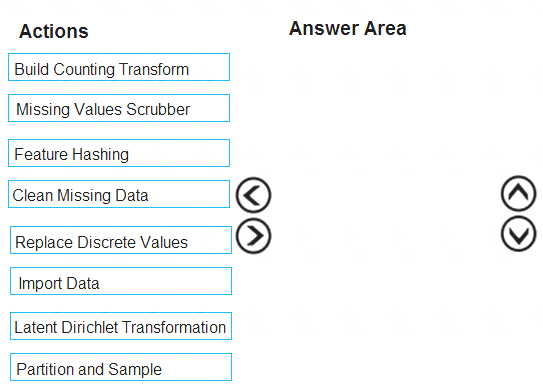- (Exam Topic 3)
You previously deployed a model that was trained using a tabular dataset named training-dataset, which is based on a folder of CSV files.
Over time, you have collected the features and predicted labels generated by the model in a folder containing a CSV file for each month. You have created two tabular datasets based on the folder containing the inference data: one named predictions-dataset with a schema that matches the training data exactly, including the predicted label; and another named features-dataset with a schema containing all of the feature columns and a timestamp column based on the filename, which includes the day, month, and year.
You need to create a data drift monitor to identify any changing trends in the feature data since the model was trained. To accomplish this, you must define the required datasets for the data drift monitor.
Which datasets should you use to configure the data drift monitor? To answer, drag the appropriate datasets to the correct data drift monitor options. Each source may be used once, more than once, or not at all. You may need to drag the split bar between panes or scroll to view content.
NOTE: Each correct selection is worth one point.
Solution:
Text Description automatically generated with medium confidence
Box 1: training-dataset
Baseline dataset - usually the training dataset for a model. Box 2: predictions-dataset
Target dataset - usually model input data - is compared over time to your baseline dataset. This comparison means that your target dataset must have a timestamp column specified.
The monitor will compare the baseline and target datasets. Reference:
https://docs.microsoft.com/en-us/azure/machine-learning/how-to-monitor-datasets
Does this meet the goal?
Correct Answer:
A
- (Exam Topic 3)
Note: This question is part of a series of questions that present the same scenario. Each question in the series contains a unique solution that might meet the stated goals. Some question sets might have more than one correct solution, while others might not have a correct solution.
After you answer a question in this section, you will NOT be able to return to it. As a result, these questions will not appear in the review screen.
You are a data scientist using Azure Machine Learning Studio.
You need to normalize values to produce an output column into bins to predict a target column. Solution: Apply a Quantiles binning mode with a PQuantile normalization.
Does the solution meet the goal?
Correct Answer:
B
Use the Entropy MDL binning mode which has a target column. References:
https://docs.microsoft.com/en-us/azure/machine-learning/studio-module-reference/group-data-into-bins
- (Exam Topic 3)
You are creating an experiment by using Azure Machine Learning Studio.
You must divide the data into four subsets for evaluation. There is a high degree of missing values in the data. You must prepare the data for analysis.
You need to select appropriate methods for producing the experiment.
Which three modules should you run in sequence? To answer, move the appropriate actions from the list of actions to the answer area and arrange them in the correct order.
NOTE: More than one order of answer choices is correct. You will receive credit for any of the correct orders you select.
Solution:
The Clean Missing Data module in Azure Machine Learning Studio, to remove, replace, or infer missing values.
Does this meet the goal?
Correct Answer:
A
- (Exam Topic 3)
Note: This question is part of a series of questions that present the same scenario. Each question in the series contains a unique solution that might meet the stated goals. Some question sets might have more than one correct solution, while others might not have a correct solution.
After you answer a question in this section, you will NOT be able to return to it. As a result, these questions will not appear in the review screen.
You create an Azure Machine Learning service datastore in a workspace. The datastore contains the following files:
• /data/2018/Q1 .csv
• /data/2018/Q2.csv
• /data/2018/Q3.csv
• /data/2018/Q4.csv
• /data/2019/Q1.csv
All files store data in the following format: id,M,f2,l
1,1,2,0
2,1,1,1
32,10
You run the following code:
You need to create a dataset named training_data and load the data from all files into a single data frame by using the following code:
Solution: Run the following code:
Does the solution meet the goal?
Correct Answer:
A
- (Exam Topic 2)
You need to set up the Permutation Feature Importance module according to the model training requirements. Which properties should you select? To answer, select the appropriate options in the answer area.
NOTE: Each correct selection is worth one point.
Solution:
Box 1: Accuracy
Scenario: You want to configure hyperparameters in the model learning process to speed the learning phase by using hyperparameters. In addition, this configuration should cancel the lowest performing runs at each evaluation interval, thereby directing effort and resources towards models that are more likely to be successful.
Box 2: R-Squared
Does this meet the goal?
Correct Answer:
A

